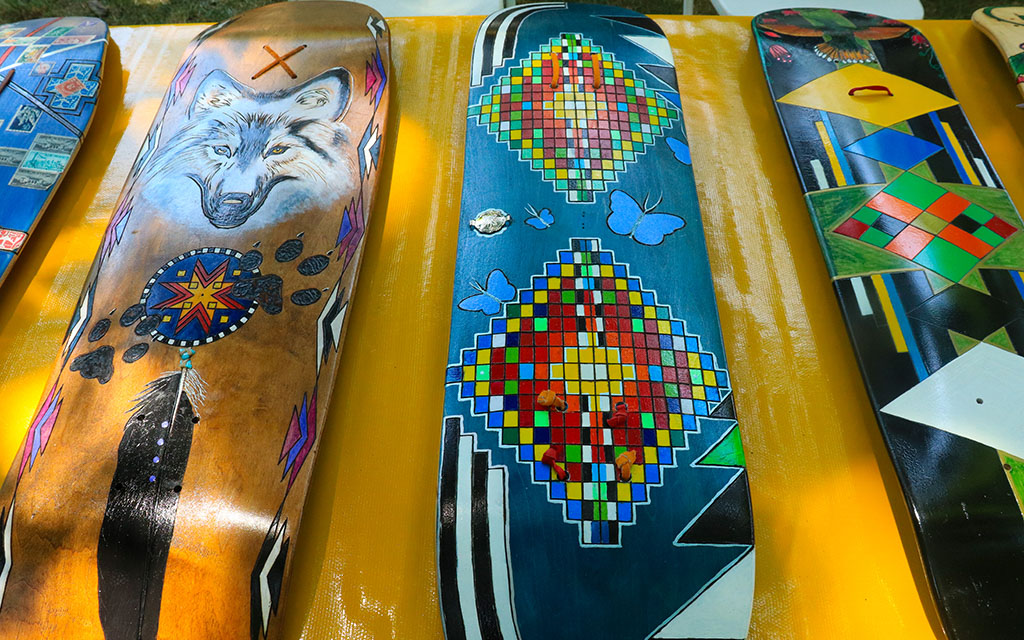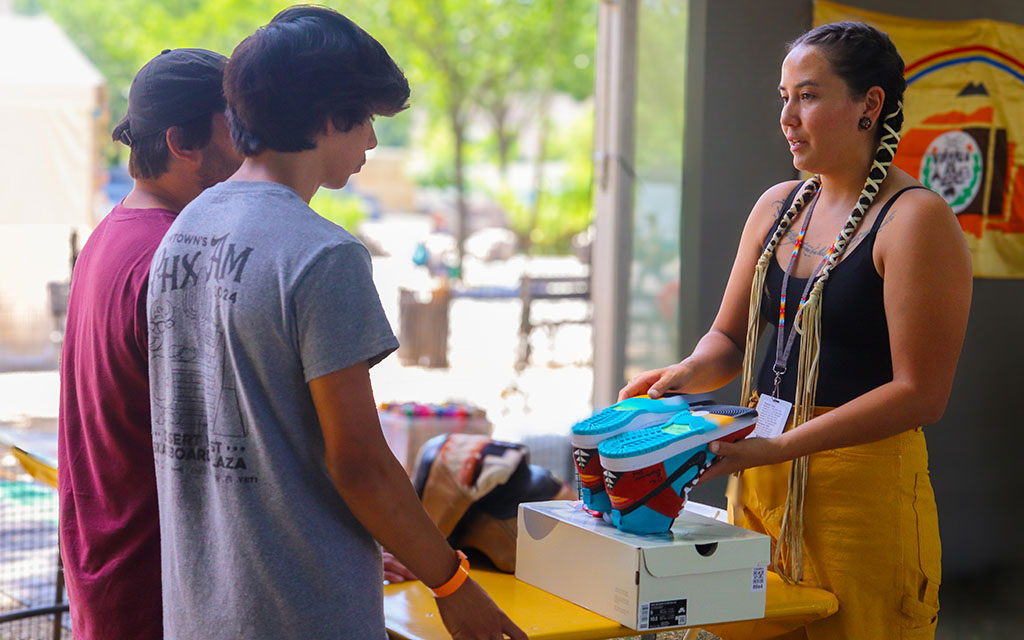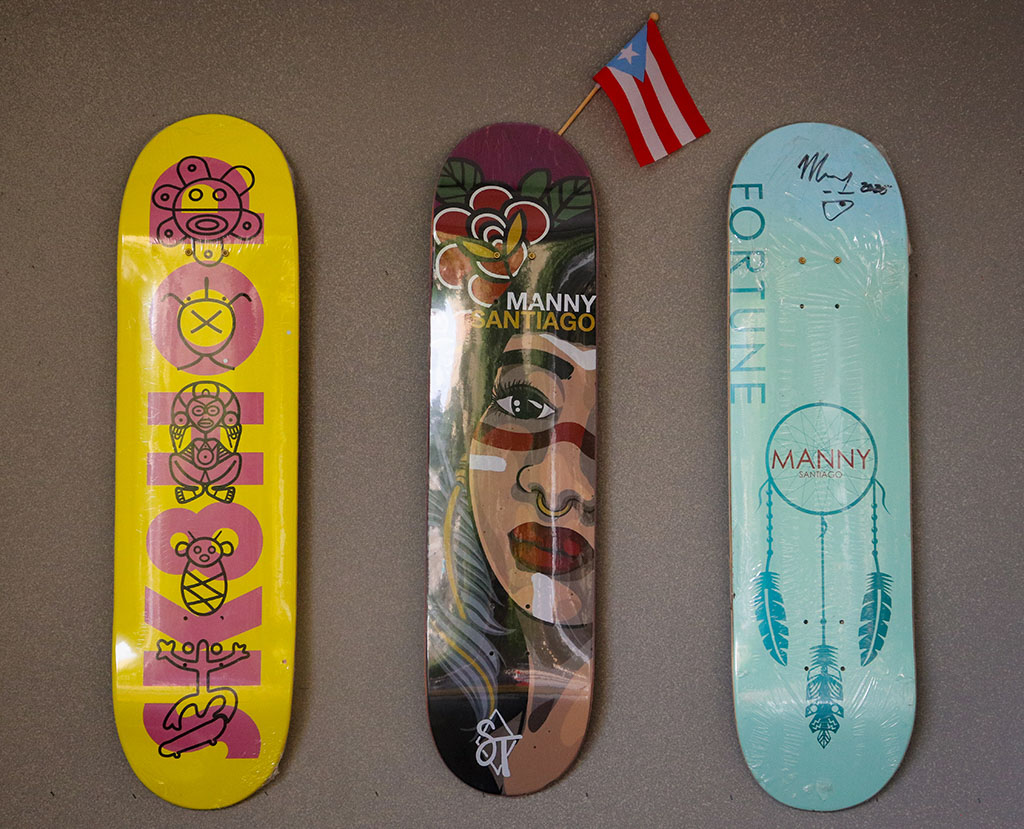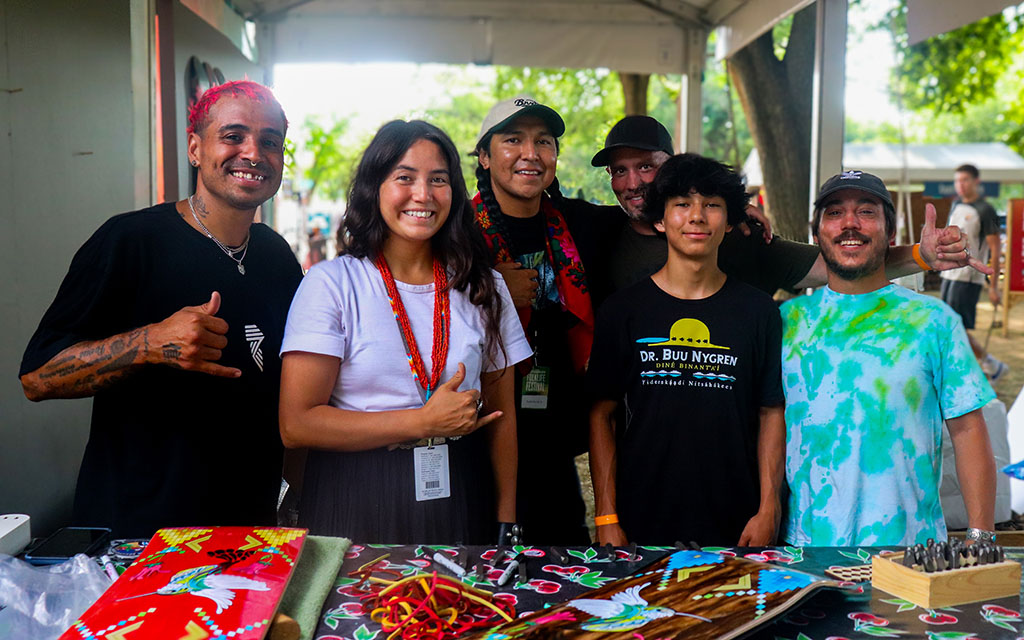Indianz.Com >
News > Cronkite News: Native skateboarders showcase artistry and heritage
 Di’Orr Greenwood with one of her handcrafted skateboards at the Smithsonian Folklife Festival in Washington, D.C., on June 24, 2024. Photo by Brianna Chappie / Cronkite News
Di’Orr Greenwood with one of her handcrafted skateboards at the Smithsonian Folklife Festival in Washington, D.C., on June 24, 2024. Photo by Brianna Chappie / Cronkite News
Skateboarding gives Navajo and other Indigenous people an outlet for artistry and heritage
Skateboarders from the Navajo Nation and other Indigenous groups “shredded it” at the Smithsonian Folklife Festival. The sport has proven to be an outlet for artistry and heritage.
Tuesday, July 30, 2024
By Brianna Chappie
Cronkite News
WASHINGTON, D.C. — The first skateboard
Di’Orr Greenwood ever rode was a cheap plastic one her grandpa had given to her younger brother.
“He had so much fun on it that I wanted a little bit of that fun, too,” she said.
When she was 22, an arson fire left the family home in ashes. They lost almost everything. But Greenwood found some old skateboards unscathed by the fire, and a tool for wood burning that her late uncle had taught her to use.
She began carving Navajo designs on skateboards to bring in money. Fast forward to 2023, and Greenwood’s designs were featured on skateboard stamps issued by the U.S. Postal Service. In June, she launched two new shoes and an apparel line for Nike SB.
Di’Orr Greenwood displays the Blazer Mids she designed for Nike at the Smithsonian Folklife Festival in Washington, D.C., on June 24, 2024. Photos by Brianna Chappie / Cronkite News
“These are the mountains that my predecessors had to overcome and move,” she said, holding up the heels of the Blazer Mids to show the ridges etched on the soles. “A tough shoe for a tough bit of history.”
The 28-year-old artist from Window Rock, the capital of Navajo Nation, seemed unperturbed by the sweltering heat on the National Mall as she showed off her handcrafted skate decks and other designs at the Smithsonian Folklife Festival, the largest annual cultural event in Washington, D.C.
 Skateboard decks made by Di’Orr Greenwood. The design at left was inspired by the Art of the Skateboard stamps she designed for the U.S. Postal Service. Photo taken at the Smithsonian Folklife Festival in Washington, D.C., on June 24, 2024. Photo by Brianna Chappie / Cronkite News
Skateboard decks made by Di’Orr Greenwood. The design at left was inspired by the Art of the Skateboard stamps she designed for the U.S. Postal Service. Photo taken at the Smithsonian Folklife Festival in Washington, D.C., on June 24, 2024. Photo by Brianna Chappie / Cronkite News
 A skateboard deck made by Di’Orr Greenwood. Photo by Brianna Chappie / Cronkite News
A skateboard deck made by Di’Orr Greenwood. Photo by Brianna Chappie / Cronkite News
Nearby, a “skate jam” had been set up with ramps and grind rails. Dozens of Indigenous skateboarders showed off their skills throughout the weeklong event.
Skateboarding is a thriving subculture on reservations, where poverty rates are high. Skateboards like the one Greenwood shared with her brother are relatively cheap. They can be ridden almost anywhere. It’s a way to find a community away from bad influences.
“All they want to do is belong,” said pro skater Manny Santiago, a Taíno who represented Puerto Rico in the sport’s Olympics debut in Tokyo at the 2020 Games.
 Manny Santiago skates at the Smithsonian Folklife Festival, in Washington, D.C., on June 26, 2024. Photo by Brianna Chappie / Cronkite News
Manny Santiago skates at the Smithsonian Folklife Festival, in Washington, D.C., on June 26, 2024. Photo by Brianna Chappie / Cronkite News
 Manny Santiago shows off his missing front tooth that he now keeps on a necklace at the Smithsonian Folklife Festival in Washington, D.C., on June 26, 2024. Photo by Brianna Chappie / Cronkite News
Manny Santiago shows off his missing front tooth that he now keeps on a necklace at the Smithsonian Folklife Festival in Washington, D.C., on June 26, 2024. Photo by Brianna Chappie / Cronkite News
Even if you haven’t heard of him, you might have played him as a character in the video game Session: Skate Sim.
He was hard to miss at the Smithsonian festival, beaming his famous missing-front-tooth smile – a signature trademark since a fall during a 2009 competition.
“Skateboarders are very stubborn. We’ll wait ’til, like, our leg is about to fall off to go to the hospital. So I waited until my face was, like, 300 pounds swollen,” he said. The abscess had put him at dire risk of a brain infection. “When they removed it, I was like, ‘I’m alive!’ I don’t care what I look like, I can skate again.”… My mom says I’m beautiful. … I don’t need anybody else’s approval.”
Riders often get hurt, which teaches resilience and determination against adversity. And there’s a counterculture vibe – all of which resonates with youth who carry the burden of historical injustices.
 Charles Cronyn showing off a hand-made skate deck given to him by his boxing instructor. The designs symbolize his Navajo heritage and a coming-of-age vision quest he recently embarked on. Photo taken at the Smithsonian Folklife Festival in Washington, D.C., on June 26, 2024. Photo by Brianna Chappie / Cronkite News
Charles Cronyn showing off a hand-made skate deck given to him by his boxing instructor. The designs symbolize his Navajo heritage and a coming-of-age vision quest he recently embarked on. Photo taken at the Smithsonian Folklife Festival in Washington, D.C., on June 26, 2024. Photo by Brianna Chappie / Cronkite News
For many Indigenous skateboarders, it’s also an outlet for cultural expression.
“A lot of Native Americans are artistic, and skateboarding is art, in a way,” said Charles Cronyn, a 15-year-old skateboarding prodigy also from Navajo Nation. “It’s a sport, but it’s also an art because people are making up new tricks.”
He was 6 when he moved with his dad from the reservation to Brooklyn. In their new urban neighborhood, his dad soon noticed his passion for skateboarding and arranged for lessons.
“And then I had to start getting him new coaches because by about 8, he just started outskating his coaches,” said his dad, Chris Cronyn.
“We’re about creating, and when a child is born they learn to create,” Chris Cronyn said.
 Charles Cronyn and his father, Chris Cronyn, talk to Di’Orr Greenwood at the Smithsonian Folklife Festival in Washington, D.C., on June 24, 2024. Photo by Brianna Chappie / Cronkite News
Charles Cronyn and his father, Chris Cronyn, talk to Di’Orr Greenwood at the Smithsonian Folklife Festival in Washington, D.C., on June 24, 2024. Photo by Brianna Chappie / Cronkite News
Last year, Diné Skate Garden opened in the Two Grey Hills chapter of the Navajo Nation, in Newcomb, New Mexico, just east of the Arizona border.
Greenwood was there, along with skate legend Tony Hawk and Navajo Nation President Buu Nygren.
Amy Denet Deal, a Navajo fashion designer, raised over $100,000 for the project, though the local tribal chapter was reluctant to sign off on construction until Greenwood came to a hearing and made an impassioned plea, recounting the positive impact skateboarding had on her life.
The Navajo Nation isn’t the only Indigenous community where skateboarding has taken hold.
 Manny Santiago’s skateboard line with Sandlot Times. The board in the middle, which shows a woman covered in traditional Taíno paint, is of his girlfriend, pro skater Christiana Means. Photo by Brianna Chappie / Cronkite News
Manny Santiago’s skateboard line with Sandlot Times. The board in the middle, which shows a woman covered in traditional Taíno paint, is of his girlfriend, pro skater Christiana Means. Photo by Brianna Chappie / Cronkite News
In 2012, Santiago was the first Puerto Rican to make it in the final three of the X Games.
“Growing up Boricua” – a native of Puerto Rico – “in my mind I always was (Indigenous), because I knew of my Taíno heritage since I was a child,” he said.
A group from Bolivia known as imillaSkate girls showcased their skill in colorful skirts called polleras – outfits imposed in the 16th century by Spanish colonizers, now reclaimed as a badge of Indigenous identity.
“We are descendants of women who wear polleras, so we are proud to wear clothing that is Indigenous,” said one of the skaters, Elinor Buitrago, 27.
 The imillaSkate girls at the Smithsonian Folklife Festival in Washington, D.C., on June 26, 2024. Photo by Brianna Chappie / Cronkite News
The imillaSkate girls at the Smithsonian Folklife Festival in Washington, D.C., on June 26, 2024. Photo by Brianna Chappie / Cronkite News
For her and other skateboarders, the fusion with Indigenous cultures is a testament to the power of community, heritage and resilience in both traditions.
“No matter your color, no matter what age you start, skateboarding is there for you,” Buitrago said. “Even though you fall down, you get up. Despite injuries, despite everything – there you are to overcome it.”
 A skater with imillaSkate girls at the Smithsonian Folklife Festival in Washington, D.C., on June 24, 2024. Photo by Brianna Chappie / Cronkite News
A skater with imillaSkate girls at the Smithsonian Folklife Festival in Washington, D.C., on June 24, 2024. Photo by Brianna Chappie / Cronkite News
That’s a recurring theme among skateboarders and part of what attracts many of them to the sport.
The Cronyns say Charles has faced discrimination in the sport as a Native American. The teen recalled a competition in South Carolina at which the judge refused to shake his dad’s hand and delivered low scores to competitors with darker complexions.
“I did everything – I didn’t miss a trick, and I probably got top three in that – and they put me at 34th place out of 35,” Charles said.
Despite such hurdles, Charles has kept a positive attitude through 10 or so professional competitions starting when he was only 9 years old – including one of the biggest in Arizona, Cowtown’s PHXAM, a hugely anticipated amateur meet at Desert West Skateboard Plaza in Phoenix.
He hopes to make the U.S. Olympics team in 2028.
Charles met Nygren last August in Window Rock during a veterans celebration event. He was there to celebrate his grandfather, an airborne ranger during the Vietnam War.
Charles gave the president an eagle feather and a skateboard, which Nygren hung in the tribal office. The president, also an avid skateboarding fan, gave Charles one of his own personal skateboards.
“It was pretty sick – he’s a really nice guy,” Charles said.
Di’Orr Greenwood shows off her Nike collaboration shoes at the Smithsonian Folklife Festival in Washington, D.C, on June 24, 2024. Photo by Brianna Chappie / Cronkite News
For Greenwood, skateboarding has been an outlet for artistic expression. She loves the way girls and women are “bringing the graces of movement, dance, femininity” into the sport, making it “a lot more artistic and beautiful to see.”
From pyrography, or wood burning, she has branched out as an artist.
 Brice Lyle, 18, Di’Orr Greenwood’s nephew, holds up one of her skateboards at the Smithsonian Folklife Festival in Washington, D.C., on June 26, 2024. Photo by Brianna Chappie / Cronkite News
Brice Lyle, 18, Di’Orr Greenwood’s nephew, holds up one of her skateboards at the Smithsonian Folklife Festival in Washington, D.C., on June 26, 2024. Photo by Brianna Chappie / Cronkite News
 Di’Orr Greenwood’s nephew, Brice Lyle, shows a visitor the woodburner tool Greenwood uses to adorn her boards at the Smithsonian Folklife Festival in Washington, D.C., on June 24, 2024.Photo by Brianna Chappie / Cronkite News
Di’Orr Greenwood’s nephew, Brice Lyle, shows a visitor the woodburner tool Greenwood uses to adorn her boards at the Smithsonian Folklife Festival in Washington, D.C., on June 24, 2024.Photo by Brianna Chappie / Cronkite News
For Nike, every detail – from the stitching of the Big and Little Dippers on the Dunk Highs to insoles that depict her Arizona roots – was designed as homage to her Diné roots.
Growing up on the reservation, she said, “the only Nikes I was ever able to have were hand-me-down Nike cleats that came from an older cousin or somebody like that.”
She’s currently heading a project to build a skatepark in her hometown of Window Rock to continue bringing the sport to more youth.
“In Indigenous communities, I feel like skateboarding is getting a lot more popular,” she said. “I feel like it’s always been around, but now it’s being acknowledged and appreciated.”
 From left, Manny Santiago; Di’Orr Greenwood; Keith Secola, an Arizona artist who’s part of the Northern Ute Indian Tribe and Anishinaabe; Jeff Deleyer, a skateboard artist; Charles Cronyn; and Charles’ father, Chris Cronyn, pose at the Smithsonian Folklife Festival in Washington, D.C., on June 26, 2024. Photo by Brianna Chappie / Cronkite News
For more stories from Cronkite News, visit cronkitenews.azpbs.org.
From left, Manny Santiago; Di’Orr Greenwood; Keith Secola, an Arizona artist who’s part of the Northern Ute Indian Tribe and Anishinaabe; Jeff Deleyer, a skateboard artist; Charles Cronyn; and Charles’ father, Chris Cronyn, pose at the Smithsonian Folklife Festival in Washington, D.C., on June 26, 2024. Photo by Brianna Chappie / Cronkite News
For more stories from Cronkite News, visit cronkitenews.azpbs.org.
Note: This story originally appeared on Cronkite News. It is published via a Creative Commons license. Cronkite News is produced by the Walter Cronkite School of Journalism and Mass Communication at Arizona State University.


















